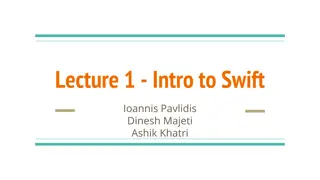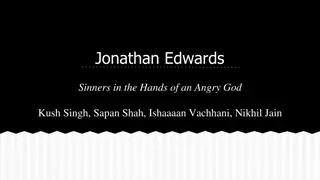Analysis of Jonathan Swift's "Gulliver's Travels
Jonathan Swift's "Gulliver's Travels" is a satirical novel that follows Lemuel Gulliver through multiple journeys to fictional lands, each representing different aspects of society and human nature. The novel highlights Swift's criticism of politics, society, and intellectual pursuits through Gulliver's encounters with various characters and civilizations.
Download Presentation

Please find below an Image/Link to download the presentation.
The content on the website is provided AS IS for your information and personal use only. It may not be sold, licensed, or shared on other websites without obtaining consent from the author. Download presentation by click this link. If you encounter any issues during the download, it is possible that the publisher has removed the file from their server.
E N D
Presentation Transcript
Literary production: A modest proposal
Gullivers Travels The novel is divided in 4 parts: 1) The ship surgeon Lemuel Gulliver is shipwrecked on the island of Lilliput. The Lilliputians are tiny people, only 6 inches tall. He helps them in the war against their enemies on another island. 2) Gulliver sets off for India, but after some disadventures, he arrives on Brobdingnag, where the inhabitants are giants. The situation of Part 1 is reversed and Gulliver is seen as a doll. He is sold to the queen and has a discussion with the king about the political situation in Europe before returning to England.
3) Gullivers lands on the flying island Laputa, populated by philosophers and scientists who care about futile scientific research and ridiculous inventions (however they anticipate some real future inventions!). He visits 2 more islands, in which old people can be kept alive for a long time. 4) He arrives on an island where there are intelligent horses, the Houyhnhnms (also the name of the island). They are served by a bestial race similar to man, called Yahoos. Gulliver tries to learn the Houyhnhnms language but they consider him similar to Yahoos. Gulliver finally goes back home, but he is disgusted by the humanness of his family and goes to live in his stable.
Interpretations of the journeys 1st journey The Lilliputians represent cruelty, pettiness (meschinit ) and provincialism and represent some political figures of Swift s England. In fact, they are initially kind to him, but later they only use Gulliver s body as a weapon against their enemy. 2nd journey The giants of Brobdingnag represent human vanity and self-love. His description of their bodies reveals a mix of fascination and disgust for human body, because it was an obstacle for the spirit. Now he sees how the Lilliputians saw him. When Gulliver describes England, Brobdingnag s king says that English people are terrible and odious.
3rd journey The Laputans are the parody of intellectual and abstract thinking, which has no connection with reality (in fact the island has no connection with the ground). This was probably an attack to the members of Royal Society like Newton. They are also a satire of England s colonial ambitions because they destroy the people living in the lands they conquer. 4 journey here there is a REVERSAL. Gulliver tries to convince the Houyhnhnms that he is not like the Yahoos, but he describes his society as violent, so they think that behind the mask of civilisation, humans are like the Yahoos.
Stylistic features At the beginning of the novel, Swift says that his style is very plain and simple. In fact Gulliver s Travels have long been considered a children s classic. Like Robinson Crusoe, Gulliver is a very pragmatic person. He describes everything with details and in the language of the traveller. However, the novel is a mix of fantasy, political satire and playfulness.
Some people consider this book critical against the humankind; others say that it s a satire only of human hypocrisy, vanity, cruelty and narrow mind. Gulliver s travels were immediately successful (10,000 copies sold in 3 weeks); it was translated in many languages and its extracts were published on weekly journals.


























